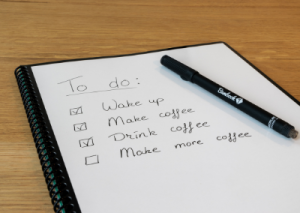
As a busy lawyer, you have many things you need to get done to ensure a smooth-running practice and a happy personal life. Like most people, you’ve likely used some kind of list to help keep you organized–perhaps even a daily to-do list. Well, this article is a list of four lists that will keep you organized and on top of your obligations.
The Psychology Behind Lists
Lists have been used throughout history to make sense of a chaotic world. In the words of the Italian philosopher and novelist Umberto Eco:
The list is the origin of culture. It’s part of the history of art and literature. What does culture want? To make infinity comprehensible… And how, as a human being, does one face infinity? How does one attempt to grasp the incomprehensible? Through lists…
Externalizing our to-dos frees up our cognitive capacity to focus on other important things. Studies by Bluma Zeigarnik suggest that when we have tasks that we need to complete, our brain has a propensity to retain that task in memory until it is completed. Only when the task is done does the brain begin the process of forgetting it. By externalizing what we need to get done, we are, in effect, making a plan (rudimentary, as it is). This plan signals that the task is complete, and we can move on to concentrate on other essential functions.
Making this plan also helps relieve any uncertainty we have around the task and how we will accomplish it. Having a detailed plan on tackling a task gives us a roadmap and gives us a sense of ease that success is possible and probable, reducing anxiety and stress.
Lists are the natural format to externalize these tasks because they complement the way people typically scan through the content. Most people follow an “F-Shaped Pattern” when presented with new material. That is they read across the first few lines at the beginning, part-way through the next few lines and then scan the material vertically down. A typical list format presents information that largely mimics this reading pattern, making it easier to absorb the information.
The list format also lends itself well to the way we process information. It is easier for us to process and remember information laid out in a simple pattern rather than in a block of text. This spatial arrangement of items also aids in memorization, reducing the likelihood of forgetting the task.
The Four Types of Lists You Need
Lists are helpful to categorize most types of information, but for our purposes, I’ll focus on lists useful in increasing productivity and getting things done.
The To-Do List
 This list needs no introduction. You’ve likely made a few to-do lists yourself. You may have a master to-do list and add items or strike off your tasks as you get them done. Or you may create a new to-do list every day.
This list needs no introduction. You’ve likely made a few to-do lists yourself. You may have a master to-do list and add items or strike off your tasks as you get them done. Or you may create a new to-do list every day.
Besides helping organize our thoughts and aid in planning, to-do lists complement our brain chemistry and help motivate us. When we strike out a completed task, that little success gives us a hit of dopamine which in turn makes us want to experience that success again. This spurs us on to the next task and the next, building on our motivation to get our to-dos done. (This explains why adding completed tasks to a to-do list and striking them out immediately is so satisfying to many of us.)
In your to-do list, it is best to list small actionable tasks rather than multi-step projects. This is useful in three ways. Smaller tasks that are quick to accomplish help with motivation, as explained above. Breaking down a larger task into smaller steps gives you a plan to tackle what might seem like a difficult assignment, relieving stress and reducing anxiety. And a list with small actionable tasks removes the need to decide on the next steps for an assignment, giving you clarity on what needs to be done and reducing decision fatigue.
The Projects List
 A project is anything that consists of multiple tasks. For example – planning a vacation is a project of many individual tasks. Putting this in the professional context, each client matter you are working on could be viewed as a project. Other non-client work you are responsible for – such as creating a playbook or implementing an automated onboarding systemv– are also projects.
A project is anything that consists of multiple tasks. For example – planning a vacation is a project of many individual tasks. Putting this in the professional context, each client matter you are working on could be viewed as a project. Other non-client work you are responsible for – such as creating a playbook or implementing an automated onboarding systemv– are also projects.
We love our projects, and it’s not surprising that we have, on an average, 15 projects on the go, at various stages (and this doesn’t even count all the client matters we’ve categorized as projects!). While your to-do list may contain actionable steps in your projects, it is still worth the few minutes to list the projects you are working on (or would like to be working on).
While you may not be tackling all your projects at the same time, you also don’t want to lose sight of them while you’re caught in the minutiae of your to-do lists. (After all, if they made your list, they’re important to you in some way). Having a list that you review regularly reminds you that they exist and may prompt you to make plans to move some of them forward (that is, add actionable items to your to-do list.).
The Pillars List
 Like literal pillars that hold up a physical structure, the pillars of your life are core areas that contribute to your life’s overall stability and balance. These are things like career and finances, relationships, spirituality, leisure, creativity, learning, and the like. Pillars are personal; they vary with the individual and reflect what you value most.
Like literal pillars that hold up a physical structure, the pillars of your life are core areas that contribute to your life’s overall stability and balance. These are things like career and finances, relationships, spirituality, leisure, creativity, learning, and the like. Pillars are personal; they vary with the individual and reflect what you value most.
Once you’ve identified the pillars of your life, it is valuable exercise to list out these pillars and some of the actions that help you nourish them. Each of your projects and to-dos should ideally map to one of these pillars. Reviewing this list regularly maintains your awareness, and studies have shown that this constant awareness, in and of itself, contributes to our discipline and success.
While to-do lists and projects lists help keep you organized and aware of your obligations, a regular review of your pillars list will keep your priorities front and centre.
The Waiting-For List
 I got the idea of a “Waiting-For List” from Chris Bailey’s book, The Productivity Project. The idea behind this list is so simple; I don’t know why I didn’t think of this myself. Basically, anything you’re waiting on goes into this list. This could be a package you’ve ordered and are waiting for, a reimbursement for a work expense, a response to an email–basically anything that you’re waiting on before you can move forward with a task or check it as complete.
I got the idea of a “Waiting-For List” from Chris Bailey’s book, The Productivity Project. The idea behind this list is so simple; I don’t know why I didn’t think of this myself. Basically, anything you’re waiting on goes into this list. This could be a package you’ve ordered and are waiting for, a reimbursement for a work expense, a response to an email–basically anything that you’re waiting on before you can move forward with a task or check it as complete.
I didn’t expect this to be the game-changer it is. Before creating my waiting-for lists (I have one for work and one for everything else), I tracked items I was waiting on in my regular to-do list. This additional noise was not helpful (I couldn’t tackle these tasks, so no dopamine hit for me) and used up unnecessary brainpower, contributing to decision fatigue. Now, anything I’m waiting on is relegated to the waiting-for list, freeing up my to-do list for actual actionable items.
How I Maintain my Lists
It might seem a bit overwhelming – from one to-do list, you now have to maintain four! In practice, it’s really not hard. You can keep track of lists on paper, digitally, or even with one of the many available apps. It doesn’t matter what you use to create these lists. What matters is regularly reviewing and maintaining these lists.
I maintain my lists digitally. I use an app for my To-Do List and Project List. I can filter my lists to see what I need to do today or this week. I can also filter my lists by the tasks associated with a project. My Waiting-For List is just a simple table listing what I’m waiting for and the expected due date. My pillars list is a simple list as well.
I review my To-Do List every morning to plan my day. I check my Waiting-For List and my Pillar List weekly when I do my weekly review (more in an upcoming post).
At work, I maintain my Project List (projects and matters) in a spreadsheet with a column that I check if I’m waiting for something to move the project forward. I can filter my spreadsheet to show me just the items I’m not waiting on to reduce the visual clutter. My to-do list is not a conventional list–I timeblock my calendar with the relevant to-dos. This increases the likelihood I’ll tackle these tasks during the time planned.
The other lists.
Of course, these aren’t the only lists you can create. You could have a “Might Do” List – a list of anything interesting that you might consider trying at some point in time. Then, of course, everyone is familiar with the Bucket List – things we must try at least once in our lifetime. And if you create content, you might have an Ideas list (like a list of topics you can write about).
Lists are simple to create, but they are powerful tools that, when used correctly, help you keep on top of your life.
And importantly, they free up your brain to work on other more important things. As David Allen, the creator of the Getting Things Done system says,
Your brain is for having ideas, not storing them.
Please share this article with your social network if you found it helpful in any way. Thank you!

0 Comments